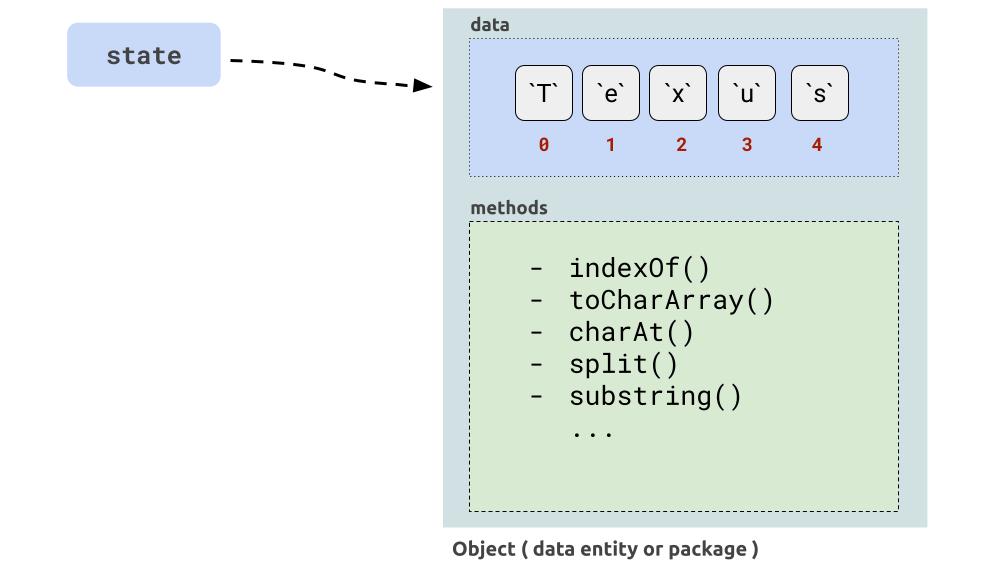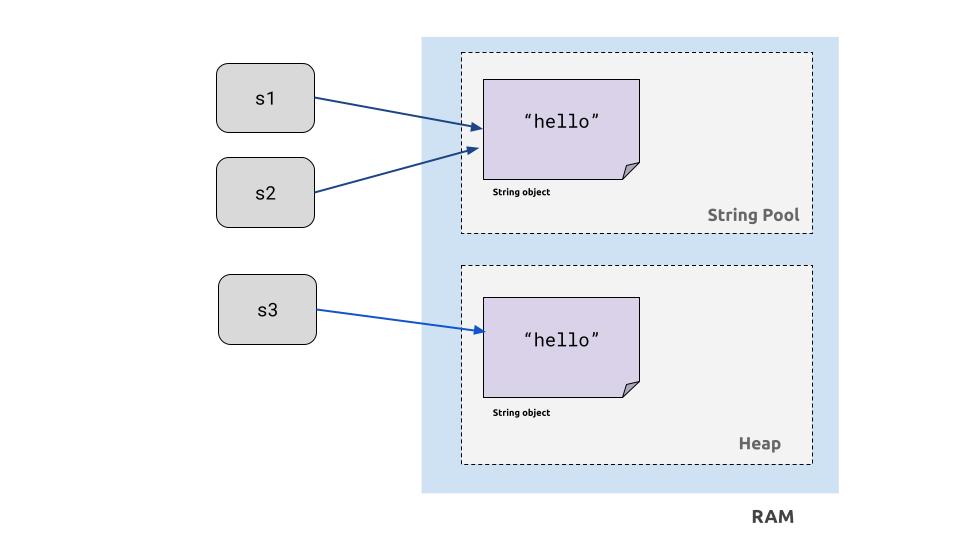String
One of the most used data in any program is a text. Java offers String class to represent textual data and its associated methods for text processing. Having a solid understanding on Java string makes you a efficient and better programmer.

In this code note, we will cover following topics:
- Into to String
- Creating String
- String Methods
› Into to String¶
String is a textual data representation in Java programming language. It is essentially a sequence of characters grouped in char array. If we have a String data "Hello" in your Java code, it would look something like this under the hood.

Where each of the characters are stored in char array and accessible via its indexes. The String data type makes it simpler for us to work with text data unlike other programming languages where you have to work with char array to represent any text data.
Text data in java is referred as String object, which is essentially a data package that contains text data as well as its convenient processing methods.
If you create a String like this
Here is how this String data or rather String object looks like internally:

› Creating String¶
In Java, you can create String object in two different ways, by String literal or by the new keyword. Both way results in String object creation and its just matter of style and preference.
Syntax for String literal:
Syntax for new keyword:
Only difference between them is that if you create a String data using the literal syntax, it will add the created String data to the String Pool for re-usage to reduce the memory usage. For example if you have the following code:
s1 and s2 will points to the same String object, meanwhile the s3 points to its own String object. This can be visually expressed as follows.

The Java's motivation behind the String Pool is that, String object is immutable object, where its data value ( text content ) is not modifiable after it was created.
Immutable Object
In computer science, an immutable object is an object ( data package ) whose data value cannot be modified after it is created. Generally most of the modern programming language represent text data object as immutable object for security benefits and memory effectivnenss.
It turns out whenever you are concatenating a String, you were essentially creating a brand-new String object instead of changing the existing one.
For example take a look at the following example:
This simple concatenation of String results in new String object being created as follows:
concatenation example

The String object "alphaleaf" will be destryoed and new String object "alphaleaf java training" will be creted.
› String Methods¶
Let's explore some important String methods that you would use in your day-to-day test automation development and also in your coding interviews.
Important String methods
We will cover following String methods. Each method is presented with one example, please make sure of the example and run it yourself.
| String methods | Returns | Usage details |
|---|---|---|
length() |
integer | returns the number of letters in a String |
indexOf(text) |
integer | returns the index of given text if it exists, else returns -1 |
isEmpty() |
boolean | returns true if the string has zero character |
contains(text) |
boolean | checks if the String contains input text |
equals(text) |
boolean | checks if the String is equal to input text |
equalsIgnoreCase(text) |
boolean | checks if the String is equal to input text ignoring cases |
startsWith(text) |
boolean | checks if the String starts with input text |
endsWith(text) |
boolean | checks if the String ends with input text |
toLowerCase() |
String | creates and returns all lowercase String based on the current String. |
toUpperCase() |
String | creates and returns all uppercase String based on the current String. |
toCharArray() |
char[] | returns char array representation of the current String |
charAt(index) |
char | returns a character at the given index number |
substring(s, e) |
String | returns a sub String from given index range |
replace(o, n) |
String | returns a new String with replacements |
split(text) |
String[] | returns a array of String that contains splits of original String |
split(text) |
String[] | returns a array of String that contains splits of original String |
compareTo(text) |
integer | compares two String, 0 if equal, -1 if smaller, 1 if bigger |
String.valueOf(input) |
String | Converts the given different data type value to String data |
concat(text) |
String | Concatenates the given text data to the current String |
length¶
This method will return an integer that represent the number of characters in given String.
indexOf¶
This method will return an integer that represents the index of given letter or word's start index in the String.
isEmpty¶
This method will return true boolean value if the String object invoking this message is empty, otherwise it will return false.
contains¶
Given the input text, this method return true if the input text exist partially in the current String. Otherwise, it will return false.
equals¶
Given the input text, this method return 'true' if the input text is 100% equals to the current String that invoked this method.
equalsIgnoreCase¶
Given the input text, this method return true if the input text is same without factoring the lower or upper-casing. This method is known as context equality.
startsWith¶
Given the input text, this method return true if the current String starts with input text. Otherwise, it will return false. Note that this method is case-sensitive. Lowercase and uppercase matters.
endsWith¶
Given the input text, this method returns true if the current String ends with input text. Otherwise, it will return false. Note that this method is case-sensitive, lowercase and uppercase matters.
toLowerCase¶
When this method is invoked on current String, it returns new lowercase version of the current String.
toUpperCase¶
When this method is invoked on current String, it returns new uppercase version of the current String.
toCharArray¶
This method returns char[] array representation of the text in current String. Note that every text data is just a collection of characters.